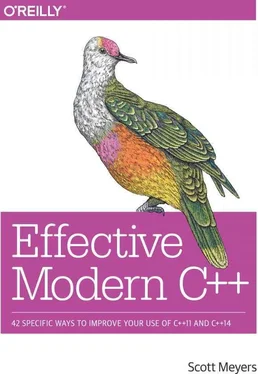class Widget {
public:
…
int magicValue() const {
std::lock_guard guard(m);// lock m
if (cacheValid) return cachedValue;
else {
auto val1 = expensiveComputation1();
auto val2 = expensiveComputation2();
cachedValue = val1 + val2;
cacheValid = true;
return cachedValue;
}
} // unlock m
…
private:
mutable std::mutex m;
mutable int cachedValue; // no longer atomic
mutable bool cacheValid{ false }; // no longer atomic
};
Now, this Item is predicated on the assumption that multiple threads may simultaneously execute a constmember function on an object. If you're writing a constmember function where that's not the case — where you can guarantee that there will never be more than one thread executing that member function on an object — the thread safety of the function is immaterial. For example, it's unimportant whether member functions of classes designed for exclusively single-threaded use are thread safe. In such cases, you can avoid the costs associated with mutexes and std::atomics, as well as the side effect of their rendering the classes containing them move-only. However, such threading-free scenarios are increasingly uncommon, and they're likely to become rarer still. The safe bet is that constmember functions will be subject to concurrent execution, and that's why you should ensure that your constmember functions are thread safe.
Things to Remember
• Make constmember functions thread safe unless you're certain they'll never be used in a concurrent context.
• Use of std::atomicvariables may offer better performance than a mutex, but they're suited for manipulation of only a single variable or memory location.
Item 17: Understand special member function generation.
In official C++ parlance, the special member functions are the ones that C++ is willing to generate on its own. C++98 has four such functions: the default constructor, the destructor, the copy constructor, and the copy assignment operator. There's fine print, of course. These functions are generated only if they're needed, i.e., if some code uses them without their being expressly declared in the class. A default constructor is generated only if the class declares no constructors at all. (This prevents compilers from creating a default constructor for a class where you've specified that constructor arguments are required.) Generated special member functions are implicitly public and inline, and they're nonvirtual unless the function in question is a destructor in a derived class inheriting from a base class with a virtual destructor. In that case, the compiler-generated destructor for the derived class is also virtual.
But you already know these things. Yes, yes, ancient history: Mesopotamia, the Shang dynasty, FORTRAN, C++98. But times have changed, and the rules for special member function generation in C++ have changed with them. It's important to be aware of the new rules, because few things are as central to effective C++ programming as knowing when compilers silently insert member functions into your classes.
As of C++11, the special member functions club has two more inductees: the move constructor and the move assignment operator. Their signatures are:
class Widget {
public:
…
Widget(Widget&& rhs); // move constructor
Widget& operator=(Widget&& rhs);// move assignment operator
…
};
The rules governing their generation and behavior are analogous to those for their copying siblings. The move operations are generated only if they're needed, and if they are generated, they perform “memberwise moves” on the non-static data members of the class. That means that the move constructor move-constructs each non-static data member of the class from the corresponding member of its parameter rhs, and the move assignment operator move-assigns each non-static data member from its parameter. The move constructor also move-constructs its base class parts (if there are any), and the move assignment operator move-assigns its base class parts.
Now, when I refer to a move operation move-constructing or move-assigning a data member or base class, there is no guarantee that a move will actually take place. “Memberwise moves” are, in reality, more like memberwise move requests , because types that aren't move-enabled (i.e., that offer no special support for move operations, e.g., most C++98 legacy classes) will be “moved” via their copy operations. The heart of each memberwise “move” is application of std::moveto the object to be moved from, and the result is used during function overload resolution to determine whether a move or a copy should be performed. Item 23covers this process in detail. For this Item, simply remember that a memberwise move consists of move operations on data members and base classes that support move operations, but a copy operation for those that don't.
As is the case with the copy operations, the move operations aren't generated if you declare them yourself. However, the precise conditions under which they are generated differ a bit from those for the copy operations.
The two copy operations are independent: declaring one doesn't prevent compilers from generating the other. So if you declare a copy constructor, but no copy assignment operator, then write code that requires copy assignment, compilers will generate the copy assignment operator for you. Similarly, if you declare a copy assignment operator, but no copy constructor, yet your code requires copy construction, compilers will generate the copy constructor for you. That was true in C++98, and it's still true in C++11.
The two move operations are not independent. If you declare either, that prevents compilers from generating the other. The rationale is that if you declare, say, a move constructor for your class, you're indicating that there's something about how move construction should be implemented that's different from the default memberwise move that compilers would generate. And if there's something wrong with memberwise move construction, there'd probably be something wrong with memberwise move assignment, too. So declaring a move constructor prevents a move assignment operator from being generated, and declaring a move assignment operator prevents compilers from generating a move constructor.
Furthermore, move operations won't be generated for any class that explicitly declares a copy operation. The justification is that declaring a copy operation (construction or assignment) indicates that the normal approach to copying an object (memberwise copy) isn't appropriate for the class, and compilers figure that if memberwise copy isn't appropriate for the copy operations, memberwise move probably isn't appropriate for the move operations.
This goes in the other direction, too. Declaring a move operation (construction or assignment) in a class causes compilers to disable the copy operations. (The copy operations are disabled by deleting them — see Item 11). After all, if memberwise move isn't the proper way to move an object, there's no reason to expect that memberwise copy is the proper way to copy it. This may sound like it could break C++98 code, because the conditions under which the copy operations are enabled are more constrained in C++11 than in C++98, but this is not the case. C++98 code can't have move operations, because there was no such thing as “moving” objects in C++98. The only way a legacy class can have user-declared move operations is if they were added for C++11, and classes that are modified to take advantage of move semantics have to play by the C++11 rules for special member function generation.
Читать дальше












